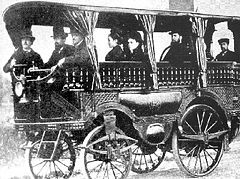
Amédée Bollée
Encyclopedia

Steam car
A steam car is a light car powered by a steam engine.Steam locomotives, steam engines capable of propelling themselves along either road or rails, developed around one hundred years earlier than internal combustion engine cars although their weight restricted them to agricultural and heavy haulage...
s. After 1867 he was known as "Amédée père" to distinguish him from his similarly named son, Amédée-Ernest-Marie Bollée (1867–1926).
Biography
Bollée was the eldest son of Ernest-Sylvain Bollée, a bellfounder and inventor who moved to Le MansLe Mans
Le Mans is a city in France, located on the Sarthe River. Traditionally the capital of the province of Maine, it is now the capital of the Sarthe department and the seat of the Roman Catholic diocese of Le Mans. Le Mans is a part of the Pays de la Loire region.Its inhabitants are called Manceaux...
in 1842. He became seriously ill in the 1860s and was obliged to delegate the day-to-day running of his businesses to his three sons. Amédée-Ernest was given charge of the bell foundry, while Ernest-Jules (1846–1922) supervised the hydraulic ram business and the youngest son, Auguste-Sylvain Bollée (1847–1906) assumed control of the Éolienne Bollée
Éolienne Bollée
The Éolienne Bollée is an unusual wind turbine, unique for having a stator and a rotor, as a water turbine has. The eponymous invention was first patented in 1868 by Ernest Sylvain Bollée in France...
wind-turbine factory.
L'Obeissante


Paris
Paris is the capital and largest city in France, situated on the river Seine, in northern France, at the heart of the Île-de-France region...
in 18 hours. L'Obeissante carried 12 passengers and had a cruising speed of 30 kilometre per hour and a top speed of 40 kilometre per hour. It was driven by two V-twin steam engines, one for each rear wheel. The original vehicle is preserved in the collection of the Conservatoire National des Arts et Métiers
Musée des Arts et Métiers
The Musée des Arts et Métiers is a museum in Paris that houses the collection of the Conservatoire National des Arts et Métiers , which was founded in 1794 as a repository for the preservation of scientific instruments and inventions.-History:Since its foundation, the museum has been housed in the...
in Paris.
La Mancelle
In 1878, Amédée père designed the Mancelle, which is regarded as the first automobile to be put into series production, 50 being manufactured in all. It possessed such (for the period) advanced features as rear-wheel drive (via shaft to the differential and then via chain to the rear wheels) and independent suspensionIndependent suspension
Independent suspension is a broad term for any automobile suspension system that allows each wheel on the same axle to move vertically independently of each other. This is contrasted with a beam axle, live axle or deDion axle system in which the wheels are linked – movement on one side affects...
on all four wheels. The original vehicle is preserved in the collection of the Musée de l'Automobile de la Sarthe.
Marie-Anne
The public demonstrations of L'Obeissante and La Mancelle had secured orders for the Bollée factory, and Amédée père accepted an order for a road trainRoad train
A road train or roadtrain is a trucking concept used in remote areas of Argentina, Australia, Mexico, the United States and Canada to move freight efficiently. The term "road train" is most often used in Australia. In the U.S. and Canada the terms "triples," "turnpike doubles" and "Rocky Mountain...
which was completed in 1879. Developing 100 hp, the Marie-Anne had a three-speed gearbox and was capable of towing 35 tons on a 6% slope.
The Marie-Anne was of a similar design to La Mancelle, with a vertical boiler mounted at the rear driving front mounted engines which transmitted their power to the rear wheels via driveshafts and chains. A tender
Tender locomotive
A tender or coal-car is a special rail vehicle hauled by a steam locomotive containing the locomotive's fuel and water. Steam locomotives consume large quantities of water compared to the quantity of fuel, so tenders are necessary to keep the locomotive running over long distances. A locomotive...
carried coal and water reserves.
La Rapide
La Rapide ("Rapid") was built in 1881 and was noted for achieving a speed of 62 kilometre per hour. La Rapide grouped the boiler, the engine and the controls at the front of the vehicle, thus making it possible for it to be driven by a single operator.External links
French:

